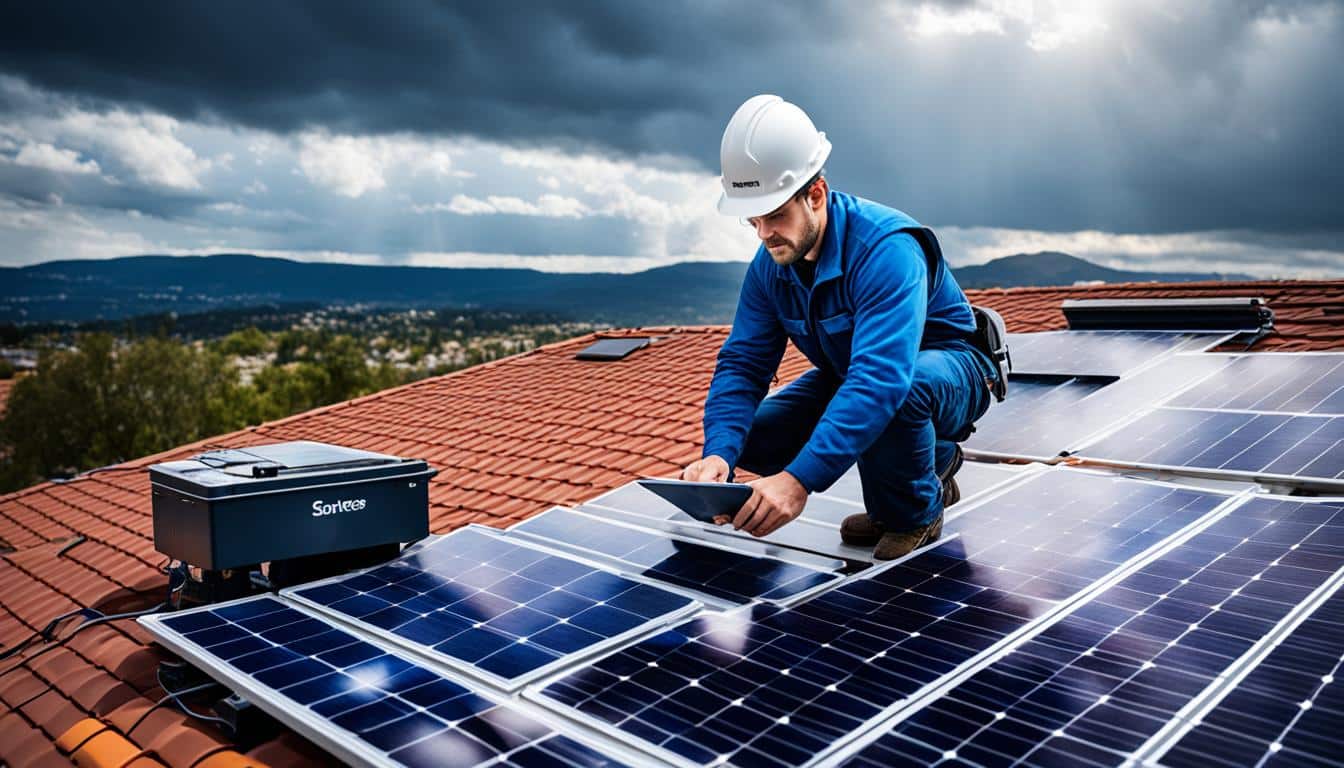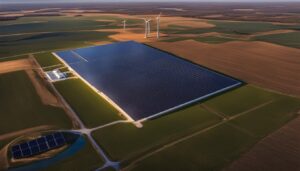
In today’s world, renewable energy sources like solar power have gained significant importance due to their clean and sustainable nature. However, the widespread adoption of solar energy still faces several challenges that need to be addressed for its successful implementation. In this section, we will explore some common problems associated with solar energy and unveil potential solutions to overcome them.
One of the primary challenges of solar energy is its intermittent nature. As solar power relies on the availability of sunlight, energy production can fluctuate based on weather conditions and time of day. This can pose challenges for grid integration and stable power supply. To tackle this issue, technological advancements in energy storage systems, such as batteries, are being developed to store excess energy generated during sunny periods for use during cloudy or nighttime periods.
Another challenge is the high initial cost of installing solar panels and related infrastructure. While the long-term benefits of solar energy are undeniable, the upfront expenses can deter many individuals and businesses from adopting this renewable energy source. To address this, various government incentives and financing options, such as tax credits and leasing programs, are being implemented to make solar energy more affordable and accessible.
Furthermore, the impact on the environment during the manufacturing, installation, and disposal of solar panels is another concern. Solar technology relies on the use of rare earth elements and potentially harmful chemicals. Stricter regulations and guidelines are being put in place to ensure the responsible production and disposal of solar panels, promoting eco-friendly practices within the solar energy industry.
Despite these challenges, several solutions are being explored to overcome the obstacles associated with solar energy. Research and development efforts are focused on improving the efficiency of solar panels, making them more cost-effective and maximizing energy conversion. Additionally, advancements in smart grid technology enable better integration of solar power into existing energy systems, ensuring seamless distribution and management of renewable energy.
By addressing these problems and embracing innovative solutions, solar energy has the potential to revolutionize our energy landscape and pave the way for a sustainable future.
Key Takeaways:
- Solar energy faces challenges related to its intermittent nature, high initial costs, and environmental impact.
- Technological advancements in energy storage systems help address the intermittency issue.
- Government incentives and financing options make solar energy more affordable and accessible.
- Stricter regulations promote eco-friendly practices in the production and disposal of solar panels.
- Ongoing research aims to improve solar panel efficiency and integrate solar power seamlessly into existing energy systems.
The Impact of Sustainable Agriculture Initiatives in Odisha
Vedanta Aluminium has launched the Jeevika Samriddhi Project, a sustainable livelihood initiative for farmers in Odisha’s Jharsuguda district. The project aims to improve the lives of farming households by implementing agriculture-based initiatives.
By focusing on pond restoration, solar pumps for irrigation, and advanced techniques like System of Rice Intensification (SRI) and WADI model, the Jeevika Samriddhi Project aims to enhance crop yields and revitalize barren lands.
The project plays a crucial role in promoting sustainable farming practices and reducing farming households’ dependency on rainwater. It provides improved irrigation facilities that enable farmers to achieve cultivation round the year.
| Initiative | Description |
|---|---|
| Pond Restoration | Revives water bodies to ensure adequate water availability for irrigation and livestock. |
| Solar Pumps for Irrigation | Harnesses solar energy to power irrigation pumps, reducing reliance on traditional energy sources. |
| System of Rice Intensification (SRI) | Utilizes innovative techniques to optimize rice cultivation, leading to higher yields and resource efficiency. |
| WADI Model | Transforms barren lands into orchards by integrating horticulture with forestry, providing sustainable income opportunities. |
Through the Jeevika Samriddhi Project, Vedanta Aluminium demonstrates its commitment to fostering sustainable agriculture initiatives that empower farming households, enhance livelihoods, and contribute to the overall development of the region.

By implementing these innovative practices, the Jeevika Samriddhi Project serves as a model for sustainable agriculture initiatives in Odisha and beyond, inspiring other regions to adopt similar practices for a more sustainable and prosperous future.
Neurorehabilitation Strategies for Aphasia After Stroke
Reperfusion therapy is a crucial treatment for individuals experiencing acute ischemic stroke. However, despite successful recanalization, some patients may not achieve significant functional improvement. This condition, known as futile reperfusion, is influenced by various prognostic risk factors and can lead to the persistence of aphasia, a language disorder.
A recent case study has shed light on the utility of multimodal neuroimaging in assessing neural damage related to prolonged aphasia in stroke patients. The study utilized diffusion MR fiber tractography and benzodiazepine receptor imaging techniques to evaluate the integrity of neuronal tracts and predict the prognosis for post-stroke aphasia.
By comprehending the intrinsic mechanisms of neuronal activity during the transition from neuroprotection to restoration, researchers aim to develop personalized therapeutic strategies for neurorehabilitation. This understanding can help improve the outcomes of individuals suffering from aphasia after stroke by tailoring treatment approaches and enhancing the effectiveness of rehabilitation programs.
Further research and advancements in neuroimaging techniques and therapeutic interventions offer promising avenues for addressing the challenges associated with aphasia after stroke. By combining reperfusion therapy with targeted neurorehabilitation strategies, healthcare professionals can strive to improve the lives and communication abilities of stroke survivors.
FAQ
What are some common problems associated with solar energy?
Some common problems associated with solar energy include high upfront costs, intermittent power generation due to weather conditions, and the need for adequate space for solar panel installation.
How can these problems be addressed?
These problems can be addressed by implementing innovative financing options, such as solar leasing or power purchase agreements, improving energy storage technologies to store excess power for later use, and exploring alternative locations for solar panel installation, such as rooftops or floating solar farms.
What are some sustainable agriculture initiatives in Odisha?
One sustainable agriculture initiative in Odisha is the Jeevika Samriddhi Project by Vedanta Aluminium. This project focuses on pond restoration, solar pumps for irrigation, and advanced farming techniques like System of Rice Intensification (SRI) and WADI model to enhance crop yields and revitalize barren lands.
How does the Jeevika Samriddhi Project benefit farmers?
The Jeevika Samriddhi Project benefits farmers by providing improved irrigation facilities, reducing their dependency on rainwater, and enabling cultivation throughout the year. It also promotes sustainable farming practices, which can lead to increased crop yields and improved livelihoods for farming households.
What is aphasia and how is it related to stroke?
Aphasia is a communication disorder that affects a person’s ability to speak, understand, read, or write. It is often caused by damage to the brain’s language centers, which can occur as a result of a stroke.
What is reperfusion therapy?
Reperfusion therapy is a first-line treatment for acute ischemic stroke. It involves restoring blood flow to the affected area of the brain to prevent further damage and promote recovery.
Why do some stroke patients with successful recanalization not achieve significant functional improvement?
Some stroke patients with successful recanalization may not achieve significant functional improvement due to factors such as prolonged periods of reduced blood flow to the brain, the presence of other underlying conditions, or damage to regions of the brain not directly involved in language processing.
How can neural damage related to aphasia be assessed?
Neural damage related to aphasia can be assessed using multimodal neuroimaging techniques such as diffusion MR fiber tractography and benzodiazepine receptor imaging. These techniques help evaluate the integrity of neuronal tracts and predict the prognosis for post-stroke aphasia.
How can neurorehabilitation strategies help in the treatment of aphasia?
Neurorehabilitation strategies can help in the treatment of aphasia by promoting neuroplasticity, which is the brain’s ability to reorganize and form new neural connections. This can be achieved through speech and language therapy, cognitive exercises, and the use of assistive technologies.
Source Links
- https://www.mdpi.com/2071-1050/16/5/2063
- https://economictimes.indiatimes.com/industry/indl-goods/svs/metals-mining/vedanta-aluminiums-jeevika-samriddhi-project-plans-to-empower-agri-entrepreneurs-in-odisha/articleshow/108139167.cms?UTM_Source=Google_Newsstand&UTM_Campaign=RSS_Feed&UTM_Medium=Referral
- https://www.mdpi.com/2308-3417/9/2/30








